News
Croquet Mallet Shafts - how to choose the most suitable
When choosing a croquet mallet you have a range of options for the shaft. From material to shape, even if you are just looking to buy a croquet set for recreational use, there are decisions to be made!
A croquet mallet should give you both power and control. There is a trade-off between the two, and mallets have changed significantly over the years to help players achieve more power whilst still retaining the control as well.
If you are choosing a croquet set for recreational games, then elements such as strength and durability my well be more important. If your friends and family are using a croquet set in the garden, or on a makeshift lawn, then cost-effectiveness will no doubt play a big part too. Naturally the “better” the mallet, the higher the cost
This article is going to focus exclusively on the shaft of the croquet mallet (see other articles for more information about the head) and will provide some background information and guidance based on what the croquet mallet (or croquet set) is going to be used for.
Ideal characteristics of the croquet mallet shaft:
- The shaft should let you generate power but there is no point in having any weight in it. The weight of the mallet should be concentrated in the head.
- The strength of the shaft is crucial. A shaft that is not strong is going to break easily when you try and generate any kind of power.
- There is another compromise here. A shaft that is rigid will provide more control but if it is too rigid then that is not beneficial either (and hitting the ball can cause significant jarring)
- No twist. The ball leaves the mallet perpendicular to the head, so if the head twists at all then the ball is likely to go off-course
Weight:
The overall weight of a mallet should be around 3lbs, so you are looking for a shaft that is as light as possible. Most of the mallets we sell are made of wood, which is a perfectly reasonable material, but again, different types of wood can provide lower weight, but better durability and a good compromise for flexibility.
Ash is a strong, and very durable wood type. The grain is fairly straight which is very important for its characteristics. Because of its strength and durability, ash wood has an range of uses and is perfectly suited for our better quality croquet sets
Other light weight materials include fibre glass and carbon. As mentioned though ash handles are the most cost-efficient and are actually also used by a majority of croquet players
Strength
This is where traditional hardwood can provide a problem – but because of the straight grain of Ash, it provides a great solution that still has the strength that is necessary. Most croquet sets don’t come with anything but hardwood or Ash handles, but better croquet mallets can be made using a variety of very strong materials.
Rigidity
Generally the composite (non-natural) materials are the most rigid, and so can provide the more uncomfortable play. Ash however is a natural timber and provides some element of flexibility, even though not at the loss of too much control.
No Twist
The twisting element can be dealt with by the shape of the shaft. Although most recreational croquet mallets have round shafts, which are perfectly sufficient for a regular game of croquet, if you are looking for more accuracy and control, the shape should be anything but round. It can vbe octagonal, or square with rounded corners
Summary
So what should you choose? Well, it depends very much what you are looking for. For recreational use standard round wood shafts are perfectly adequate. They will keep the cost down, and where the power and direction are not the main factors there is no need to spend more! For more durability and strength our croquet sets come with mallets with Ash shafts.. These tend to last longer, and provide a better quality mallet. If the shaft or even just the handle are octagonal then this is even better. If you are very serious about your croquet then it might be worth thinking about composite materials.
As a rough guideline costing ranges are as follows (dependent on other factors as well):
1) Standard round hardwood shaft - £30
2) Ash handle - from £60
3) Composite (with quality head) - from £100
Click here to view the mallets we stock - we wish you the best of luck with your mallet choice!
- Andre Boeke
Croquet Balls
 Croquet Online offers a range of croquet sets, many of which have different croquet balls. For those looking to play a formal game, the regulation croquet ball will be the most relevant. However, for those looking to play recreationally, with family, or just in a garden for fun, then your requirements are very different.
Croquet Online offers a range of croquet sets, many of which have different croquet balls. For those looking to play a formal game, the regulation croquet ball will be the most relevant. However, for those looking to play recreationally, with family, or just in a garden for fun, then your requirements are very different.
Regulation Croquet Balls
Regulation croquet balls are for tournament croquet, so only need to be considered if you want to buy a croquet set for serious play! Regulation croquet balls are not just about how much they weigh and what they are made of – things such as the bounce height of the ball, the weight tolerance also come into play.
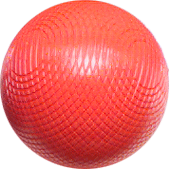 Regulation balls are 3 5/8” in diameter (plus or minus 1/32” (0.08cm) and weigh exactly 16oz (0.454kg – plus or minus 1/4oz, or 7g). To be regulation the croquet ball will also be tested for rebound (between 30 and 45in or 75 and 112.5cm) when dropped from 60in or 150cm onto a steel plate which is 1in thick and set rigidly in concrete. The bounce is not the only important thing, the consistency of the bounce is also measured, and the bounce height must not differ by more than 3” or 7.5cm.
Regulation balls are 3 5/8” in diameter (plus or minus 1/32” (0.08cm) and weigh exactly 16oz (0.454kg – plus or minus 1/4oz, or 7g). To be regulation the croquet ball will also be tested for rebound (between 30 and 45in or 75 and 112.5cm) when dropped from 60in or 150cm onto a steel plate which is 1in thick and set rigidly in concrete. The bounce is not the only important thing, the consistency of the bounce is also measured, and the bounce height must not differ by more than 3” or 7.5cm.
Standard tournament balls are made from a composite core with a plastic cover, which makes them more durable than the traditional wooden croquet ball.
Regulation croquet balls have to be approved by the Croquet Association – which will carry out the above tests to ensure the balls meets all the standards required. These balls are usually marked as “tournament approved”.
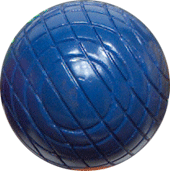 Croquet Online doesn’t currently sell any Croquet Association approved balls – but please see the Croquet Association website for more information.
Croquet Online doesn’t currently sell any Croquet Association approved balls – but please see the Croquet Association website for more information.
Non Regulation Croquet Balls
You can also get Croquet Balls which although not Croquet Association approved (so technically not “regulation” balls, are still the same weight and material. This means that they are still 3 5/8” in diameter, weight 16 ounces and made of composite. They also have a pattern of grooves on the ball to ensure that they grip other croquet balls when they impact them during a game.
Recreational Use
The balls sold with the Croquet sets at Croquet Online are generally all meant for recreational use. This means that we offer both traditional wooden balls and more durable composite ones. We also sell a variety of weights, and this is something to take into account when choosing a croquet set. Whilst the 3 5/8” 16oz ball will provide the most consistent and best play, it is not going to be suitable for children (the ball will be too heavy) and should only be used with appropriate croquet mallets. A good ball being hit with a lower standard mallet is going to potentially damage the croquet mallet as well as make it harder to hit the ball so harder to play well.
Material
Balls are either made using traditional wood, or from composite. Although the composite is without a doubt more durable and provides a more consistent and better game of croquet, you have to balance this out against the extra cost and whether you have the right quality of mallet. Composite balls come in different sizes as well, whereas the wooden balls tend to be 12oz, which is the most suitable for children.
Composite Croquet Balls
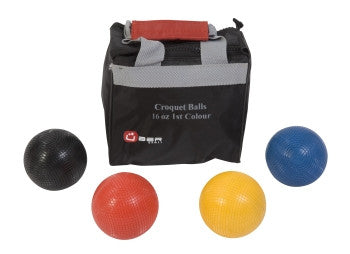 Pros
Pros
- Durability – composite balls do not get damaged when you hit them (either with a mallet or with another ball)
- Consistency – composite balls are more consistent than wooden ones (related to durability)
Cons
- Composite balls cost more than wooden balls. Uber wooden 12oz balls can be purchased for £30 for a set of four, whilst a composite set of four 12oz balls will cost £50
- Can only be used with superior quality mallets
Wooden Croquet Balls
Pros
- Cheaper than composite balls
- Suitable for garden recreational croquet
- Suitable for younger people
Cons
- Not as durable, and likely to get marked / chipped.
- Not as consistent as composite balls when hit
Size
Although there is not an enormous difference in size of balls, it is definitely worth bearing in mind who is going to be playing with the croquet set before you decide anything as weights do differ subsantially. We sell balls weighing from 9oz, to 16oz – which equates to 3in in diameter up to 3 5/8in. The actual size of the balls therefore is not hugely variant, but children are going to find it much harder to play with the heaviest balls. As mentioned above, the heavier balls will also need better croquet mallets to prevent a mismatch.
Primary and Secondary colours
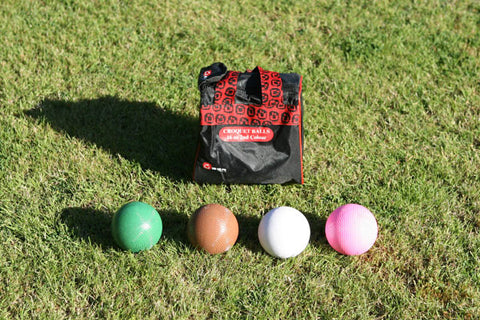 4 Player Croquet Sets come with 4 balls – containing the primary croquet colours. These are red, black, blue and yellow. If you are going to play with more players you can supplement your set with a set of secondary colour balls, which are green, white, brown and pink.
4 Player Croquet Sets come with 4 balls – containing the primary croquet colours. These are red, black, blue and yellow. If you are going to play with more players you can supplement your set with a set of secondary colour balls, which are green, white, brown and pink.
The 6 player sets naturally already come with 6 balls (the primary colours and then the green and white from the secondary set).
What does each set have?
- Family Croquet Set from Uber Games - Wooden Croquet Balls, 9oz and 3” diameter
- Junior Executive Croquet Set from Uber Games - Wooden Croquet Balls, 9oz and 3” diameter
- Sandford Croquet Set from Garden Games - Wooden Croquet Balls, 2 sizes – 12oz and 6oz
- Garden Croquet Set from Uber Games - Wooden Croquet Balls, 12oz and 3 5/8” diameter
- Pro Croquet Set from Uber Games – Composite Croquet Balls, 16oz and 3 5/8” diameter
- Longworth Croquet Set from Garden Games - Composite Croquet Balls, 16oz and 3 5/8” diameter
- Townsend Croquet Set from Garden Games - Composite Croquet Balls, 16oz and 3 5/8” diameter
- Townsend 6 Player Croquet Set from Garden Games - Composite Croquet Balls, 16oz and 3 5/8” diameter
- Longworth 6 Player Croquet Set from Garden Games - Composite Croquet Balls, 16oz and 3 5/8” diameter
- 6 Player Pro Croquet Set from Uber Games - Composite Croquet Balls, 16oz and 3 5/8” diameter
- Executive Croquet Set from Uber Games - Composite Croquet Balls, 16oz and 3 5/8” diameter
- Championship Croquet Set from Uber Games - Composite Croquet Balls, 16oz and 3 5/8” diameter
- Hurlingham Croquet Set from Garden Games - Composite Croquet Balls, 16oz and 3 5/8” diameter
Costs of Croquet Balls
Croquet Online offers Uber Games balls starting from £30 for a set of four (primary or secondary colours). These are 12oz wooden balls, and the price increases with size and for composite balls. A set of 4 16oz composite balls costs £60. You can buy tournament balls from and also single balls from the Croquet Association who offer both lighter weight Garden Croquet balls (such as Townsend and Longworth balls) as well as CA Approved Croquet Balls from Sunshiny and Dawson. These range from £200 for a set of 4 to £360 for the set.
To buy croquet balls separately please see our dedicated section with a range of wooden and composite primary and secondary colour balls. They are all provided with their own storage bag per set.
- Andre Boeke
History of the Game of Croquet
History of Croquet
The beginnings of croquet are unclear – with evidence of similar games dating back hundreds of years. There are stories from up to 800 years ago of games placed with balls, hoops and sticks. A Dutch game from the mid 1600’s which is still played today is could be part of the croquet heritage. Played with metal ring, and wooden balls, the equipment is relatively similar. Another game, termed Pall Mall (or variations thereof!) has also been documented as being played in France. With mallets and smaller wooden balls, there seems to be a striking resemblance to current croquet sets. This was also played in London according to Samuel Pepys.
Evidence is sketchy at best, and only in the mid 1800’s did croquet start appearing again. Credit is given to the Jaques family for introducing it into the UK, even though they first saw a new game called Crookey being played in Ireland which they brought to the UK. The Jaques family were supplying sporting goods to the middle class at this stage, and had successfully cornered this market, allowing croquet to reach a very captive audience.
At this stage croquet was a very new game, and if it were not were for Walter James Whitmore, it may well have never become as popular as it is today. Whitmore was a failed poet, novelist and inventor, but threw himself into croquet and developed the strategy, tweaked the rules, wrote a guide with tactics and was an instrumental part of croquets first open tournament. Incidentally, he also became the first champion!
All England Croquet Club
The game of croquet spread across the South of England, particularly along the coast, where Whitmore was based. The first club to be set up was at Worthing, in West Sussex in 1860. Following the formation of these croquet clubs, a national centre in London was founded – the All England Croquet Club at Wimbledon. Unfortunately, controversy soon took hold, with Whitmore setting up a rival organisation called the National Croquet Club. Although this organisation did finally merge with the All England Croquet Club, Whitmore continued to cause fractures, and set up another rival croquet organisation, which was wound down when he passed away in 1872.
Around this time a new game was also appearing, which soon overtake croquet in both popularity and prevalence. Lawn tennis was given some space at Wimbledon and it rapidly took over, as croquet became less and less popular. Soon the headquarters were rebranded as the All England Croquet and Lawn Tennis Club, and around 10 years later (1882), croquet was removed from the name altogether.
Development of Croquet
Although tennis almost caused the demise of the game of croquet, and it’s popularity significantly waned, it proved a resilient game, and a resurgence occurred in the 1920’s, after the first World War. With the introduction of more clubs, a growing middle class, the game began to be played more and more. As had happened before though, the Second World War was to once again nearly bring about the demise of the game. This time many croquet clubs were forced to close. As a game of leisure for the middle class, croquet has been at risk numerous times - but each time, in the following decades has seen a significant revival.
1962 saw a group of undergraduate compete in a croquet tournament which arguably turned the corner for croquet. Traditionally a game for older people, this interest from younger people generated a completely new interest and enthusiasm.
It was only relatively recently that the latest resurgence saw the increased influence of the Croquet Association, to provide a central co-ordination and umbrella organisation for all the croquet clubs around the country. Currently based at Cheltenham Croquet Club where many croquet events are held, it was relocated here from the Hurlingham Club in London.
Croquet Internationally
As croquet had come to Britain whilst it still had an empire, the game quickly spread to the colonies, with New Zealand and Australia in particular taking a keen interest.
New Zealand saw its first croquet club formed in 1879, with the Canterbury Association soon following in 1910, made necessary as the number of clubs grew. The New Zealand Open Championship which was first held in 1913 was an overriding success, and ultimately this all led to the formation of the New Zealand Croquet Council in 1920. Unaffected by the war in Europe, membership and interest flourished, and it soon became more popular than it was in England. In recent times the game of croquet has maintained its popularity and it continues to flourish in New Zealand.
Australia saw a similar growth in interest of croquet – with clubs and associations forming in the begin 1900’s. 1925 saw the first test matches played between England and Australia. A trophy donated by MacPherson Robertson gave rise to the MacRobertson shield which is to this day keenly contested between various nations.
Equality in Croquet
In New Zealand Croquet was from the offset also played by women. As the clubs were traditionally associated with bowls clubs which banned women from playing, many turned to Croquet as a game which they could enjoy and compete in on a level footing to men. As bowls opened up to women in the middles of the twentieth century, the croquet membership dwindled. It was a couple of decades later that this trend of female membership started reversing and croquet once again became more popular with women.
Croquet in Australia has mainly been played by women - in the 1980’s nine tenth of the players were women, with many of them falling into the middle age and older demographic. Similar to New Zealand, bowls was prohibited for women, which led them to turn to croquet. Although the balance between men and women is returning the majority of the players who compete are men.
- Andre Boeke
Choosing Mallets for your Croquet Sets
 The most important part of your croquet set is your mallet.
The most important part of your croquet set is your mallet.
Croquet equipment that comes with a croquet set usually consists of mallets, balls, hoops and a center peg or winning peg. The most important of these components, however, is the croquet mallet. This accessory, whether for professional, social or casual players, is not only important in that it must feel comfortable, but is also key for making clean and accurate shots.
Mallet size can matter- if in doubt, go larger.
Choosing a proper mallet for a more regular social play can be a daunting task. There are different materials, styles of heads, shaft styles, lengths and weights. Children's croquet equipment obviously boasts smaller mallets, but for adults the size differences can either make or break your game. Which croquet set you choose, often determines the size of your mallet. For instance, indoor sets have smaller, lighter mallets than garden sets. Normally, however, a mallet is around 2 to 3 pounds and generally 36 inches in length. Purchased individually or custom made, the length and weight can vary depending on your play style, need and preference. If you are in doubt about your mallet's size, larger is better. Choose a shaft that is an inch or two longer than your first guess, giving you some room for manoeuvre. If it is too long, you can always shorten the mallet. Heavier and larger heads lead to fewer mis-hits. Narrower heads keep hoops from hindering your shots; however, they often cause terrible mis-hits for the less experienced. Overall, larger heads are generally more accurate.
Croquet mallet heads.

The mallet head comes in different sizes, shapes, styles and materials. The one thing that all heads share is the beveled edges that range from between an eighth of an inch to a sixteenth of an inch. The edges around the head are beveled to keep from chipping or denting your head as well as from chipping or cracking the croquet balls during your strike. While most heads are wood and can be hollowed out to add metal balls or rods for weight, some are molded from stainless steel or carbon fiber. Some heads are round, while others are square. In certain cases they are a beautiful mix of both.
Brass rings protect your heads.
Having a head with brass rings, or ferrules, as protection will extend the life of your wooden croquet mallet head. Some croquet sets generally do not have these protective measures, so keep this in mind. These rings keep your head from splintering or chipping in the case of mis-hits. They also add heft to make it more stable. While these rings are mostly functional, they can also lend beauty and style to your otherwise plain croquet mallet. Mallets with brass rings are consistent with the better and also more expensive croquet sets on the market.
End plates are not just for protection.
 End plates can adorn both faces of the mallet head. These are often fashioned from a durable plastic, usually Perspex or Tufnol. Like the brass rings, end plates keep your head from damage. Recently however, rules have allowed the use of metal. These increase the head length and create increases in inertia and striking face mass. The functionality also aids in accuracy, keeping your mallet from twisting on off-center strikes and lending stability during your swing.
End plates can adorn both faces of the mallet head. These are often fashioned from a durable plastic, usually Perspex or Tufnol. Like the brass rings, end plates keep your head from damage. Recently however, rules have allowed the use of metal. These increase the head length and create increases in inertia and striking face mass. The functionality also aids in accuracy, keeping your mallet from twisting on off-center strikes and lending stability during your swing.
A mallet's weight and length matters.
Mallets range in weight - between 2 and 3 pounds. The heavier the weight, the sturdier it is. With this in mind, it is also worth mentioning that the heavier your head, the stronger your shaft should be. When it comes to play, mallet head length can be a conundrum. Longer heads benefit roll shots, while stop shots are easier with a shorter head. Finding a middle ground is not always easy. However, the better you get at the game, the less of an issue this becomes. For social play this is less of a factor.
 What materials are mallet heads made of?
What materials are mallet heads made of?
Most often, a mallet head is made of a hard wood such as hickory or ash. These enable drilling for added custom weights and other personalization. In recent years, however, more high tech heads are available. Carbon fiber and steel are common among croquet sets now, and offer different benefits such as durability and the reduction of added weight. However, starting off with a wooden mallet will enable you to find the weight that best suits your style of play.
Croquet shafts.
A good croquet mallet needs a good shaft. The shaft needs to be sturdy enough to support the head's weight, and strong enough not to shatter near the head on hard shots.
Structure of the handle does matter.
There are two different styles of handles for most mallets - those that are round, and the octagonal ones. This is mostly a matter of preference. Octagonal handles enable you to find the orientation of your head without looking. Round shafts force you to look at your head to make sure it is facing the correct direction.
Having a cushioned grip on your handle provides comfort, especially for metal shafts. Hard hits with a metal shaft can sting your hand but a well-padded grip minimizes pain and shock. Having a roll grip near the head also offers better control for roll shots.
With handle and grip styles, you need to know specifics. Wooden shafts have a few drawbacks from other firmer materials. If the wood is not hard enough, it can give during a strike and decrease your accuracy. Ensuring you have a hardwood shaft or a stronger material prevents this slight bend. On the other hand, the rigidity of your shaft is also a matter of personal choice and comfort. No matter what you choose, a shaft should be light - around 14 ounces. If you do choose wood as your material, adding a sturdier 12" rod from the head decrease your chances of snapping your shaft during harder strikes.
Which mallet is best for you?

For a social player, whether competitive or just for fun, finding the proper croquet equipment for your game can be as easy as finding what is available and what your preferences are. Find a mallet that is to your liking and the rest will follow. Once you have your mallet chosen, the rest depends on where you are playing. Croquet sets with heavier, regulation balls (16 ounces) are more for sculpted croquet lawns and heavier mallets. Lighter weight balls (12 ounces), for normal recreation, are better for gardens and normal lawns and are less of a risk to lighter mallets. If you choose to play indoors, the choice of hoops and winning pegs narrows down to weighted equipment, while lawns use wire hoops. The thicker and narrower the hoops, the closer you get to tournament standard and a more difficult game.
Packaging to suit your needs
The last thing you should think of is how you will store your croquet set. This depends on how much travel you will do with your set. Where you go, how mobile it needs to be, and how much croquet equipment you have will determine whether you need a wooden box, toolkit croquet set bag, a simple nylon bag, or a convenient trolley. No matter what your needs, there is a cost effective and safe solution to store and transport your croquet set for each use.
- Andre Boeke
Croquet Buyers Guide
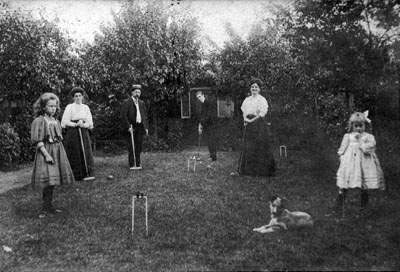 Croquet sets have been made since the mid 1800’s. The sets generally contain everything you need to enjoy the game of croquet. Once you have decided which set is most appropriate with regards to the quality of the components, the other thing to consider is how big the set is. Do you need a 4 person set, or a 6 person set? Will you be playing informally and will sharing mallets and balls be ok? More on this later!
Croquet sets have been made since the mid 1800’s. The sets generally contain everything you need to enjoy the game of croquet. Once you have decided which set is most appropriate with regards to the quality of the components, the other thing to consider is how big the set is. Do you need a 4 person set, or a 6 person set? Will you be playing informally and will sharing mallets and balls be ok? More on this later!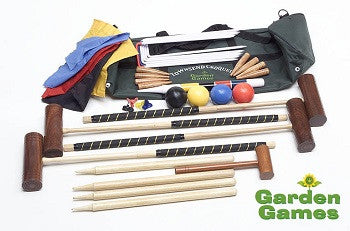
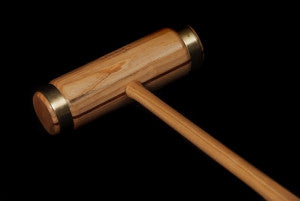 Superior croquet sets tend to come with stronger handles (made with hardwoods such as Ash), and potentially octagonal handles. Stronger handles means there is less give in the mallet making it more durable and ensuring you can strike the ball more cleanly. They will also jar less. The last aspect of the handle is the grip with more expensive croquet mallets you will get better grips.
Superior croquet sets tend to come with stronger handles (made with hardwoods such as Ash), and potentially octagonal handles. Stronger handles means there is less give in the mallet making it more durable and ensuring you can strike the ball more cleanly. They will also jar less. The last aspect of the handle is the grip with more expensive croquet mallets you will get better grips.
 Although you will not be choosing a croquet set based on the hoops it is worth knowing the difference in quality and what makes a quality croquet hoop. Generally, the thicker the wire of the hoop, the stronger it is and the more expensive! Thicker wire and smaller hoops (smaller gaps) are more likely to be tournament standard. For garden croquet hoops with extended legs which can be pushed into the ground are sufficient. Regulation and championship sets may come with a hoop drill and a hoop mallet (otherwise know as a smasher mallet).
Although you will not be choosing a croquet set based on the hoops it is worth knowing the difference in quality and what makes a quality croquet hoop. Generally, the thicker the wire of the hoop, the stronger it is and the more expensive! Thicker wire and smaller hoops (smaller gaps) are more likely to be tournament standard. For garden croquet hoops with extended legs which can be pushed into the ground are sufficient. Regulation and championship sets may come with a hoop drill and a hoop mallet (otherwise know as a smasher mallet).- Mallets
- Balls
- Hoops
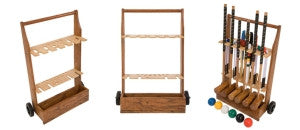 Packaging
Packaging- Andre Boeke
 What materials are mallet heads made of?
What materials are mallet heads made of?